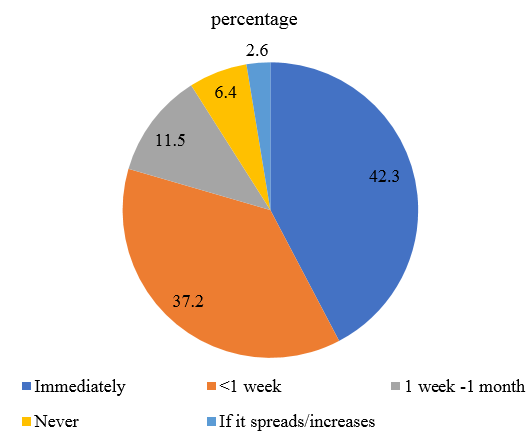Introduction
Vitiligo is an acquired skin disorder caused due to destruction of melanocytes which clinically presents with well defined depigmented macules and patches with or without white hairs.1 About 1% of the world’s population is estimated to be affected by vitiligo.2 Vitiligo usually has its onset at 10 to 30 years of age but can occur at any age.3 Autoimmunity, intrinsic defects of melanocytes, and oxidative stress are considered to be the pathogenesis but is not clearly known, usually it is multifactorial.4 Numerous studies show that patients with vitiligo feel stigmatized, have low self esteem & suffer a psychosocial burden. There are lot of taboos around the word due the lack of knowledge & attitude regarding this disease. The present study is an attempt to document the prevalent knowledge and attitude in the general public regarding this disease and to identify the determinants of good/poor knowledge and attitude.
Materials and Methods
A cross-sectional survey was done among the general population visiting DVL OPD @ Sree Balaji medical college & hospital using a self-reported questionnaire from January to February 2021. Individuals who were 18 to 60 years of age were included in the study. Questionnaire was designed in manner that general population can understand & was distributed randomly irrespective of gender. The sample size was calculated using a single population proportion formula considering 60% [19] anticipated sufficient knowledge, a confidence level of 95%, and 5% margin of error giving a total of 80 samples
Results
Out of total 80 subjects, 79 completed the questionnaires giving 97% response rate.
As illustrated in this table, most of the people recognized that vitiligo is not communicable (63.3%), not connected with lack of hygiene (58.2%) & does not spread by sharing things (57%). A good number of responders had knowledge that vitiligo is a hereditary disease (63.3%) & flares up during stress (68.4%) & sun exposure (58.4%). Majority of the responders were aware that treatment is available (82.3%) however most of them were not aware regarding surgical management of vitiligo (70.5 %).Table 1
As shown in Table, most responders would sympathize with patients having vitiligo (69.2 %), would marry (59%) & continue their marital life (60%).Two-third (79.5%) of the respondents came with positive attitude of not staring at vitiligo patients. The study also revealed that more than half of the respondents would be willing to employ a vitiligo patient as employers (57%), would be willing to share foods with vitiligo patients (61.5%), and would eat the food prepared by a vitiligo patient (61.5%). Yet, merely half of the respondents (41.8%) would ask vitiligo patients about their disease. A sizeable respondents still have a negative attitude towards vitiligo patients by avoiding shaking hands with a them (53.8).Table 2
As shown in this table and figure, three – fourth of the responders were well informed to visit the dermatologist (78.8) if they have a skin problem & to immediately (42.3%) consult a doctor if you notice a skin lesion in child. The reason for not consulting a skin doctor among the responder was mostly that they didn’t notice the skin lesion (64.9%). Overall the responders gave a positive response. The dependence on alternative medicine is comparatively less.Table 3
Table 1
Knowledge about vitiligo
Table 2
Attitude about vitiligo
Table 3
Behaviour among general population towards vitiligo
Discussion
The aim of this study is to get a survey about the knowledge, attitude & practices towards vitiligo patients in general population. The result we obtained was interesting merely three fourth of the respondents gave a positive response. They were well aware that vitiligo is not communicable (63.3%), not connected with lack of hygiene (58.2%) & does not spread by sharing things(57%). A good number of responders had knowledge that vitiligo is a hereditary disease (63.3%) & flare up during stress (68.4%) & sun exposure (58.4%). Three-fourths of the responders were aware of the treatment (82.3%). The response we got in our study about the knowledge of the respondents towards vitiligo is same as a Survey in Mekelle City, Northern Ethiopia. 5 The responder would sympathize with patients with vitiligo (69.2 %), would marry (59%) & continue their marital life (60%). Two-third (79.5%) of the respondents came with positive attitude of not staring at vitiligo patients. The study also revealed that half of the respondents would be willing to employ a vitiligo patient as employers (57%), would be interested to share foods with vitiligo patients (61.5%), and would eat the food prepared by a vitiligo patient (61.5%). Yet, merely half of the respondents (41.8%) would ask vitiligo patients about their disease. A sizeable respondents still have a negative attitude towards vitiligo patients by avoiding shaking hands with a them (53.8). The overall attitude was comparatively poor which resembles same as a hospital-based study conducted by C.M Gupta et al.6 on knowledge and attitude related to vitiligo among adults visiting a tertiary health facility of central India.
Three – fourth of the responders were well informed to visit the dermatologist (78.8) if they have a skin problem & to immediately (42.3%) consult a doctor if you notice a skin lesion in child. The dependence on alternative medicine is comparatively less. The majority of the participants had good knowledge score, while only had good attitude score.
Conclusion
There are lot of misconceptions & myths regarding vitiligo prevalent in the studied population. The knowledge scores were better than attitude scores. This study gave us a valuable information about the people’s awareness about vitiligo which will help us to overcome these shortcomings through the conduction of awareness program to better educate the general public.




